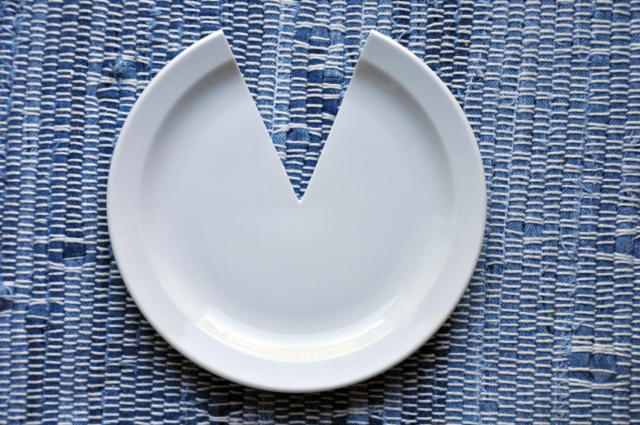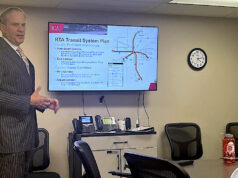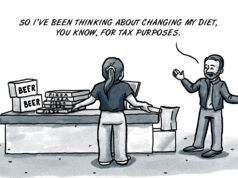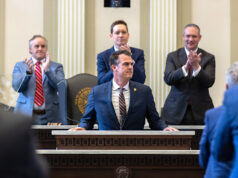
When Gov. Mary Fallin delivered her annual State of the State address to the Oklahoma Legislature on Feb. 6, the topic on everyone’s mind was how to address the budget crisis facing the state.
Fallin, who described her solution as “a series of bold reforms,” proposed eliminating certain taxes, raising others and instituting new taxes.
Conservatives apparently believe all that is really needed is to reduce state spending even further. The conservative Oklahoma Council of Public Affairs (OCPA) has published a list of areas in which government spending could be reduced. While the list deserves consideration, it would result in $413 million saved — less than half of the projected revenue shortfall of $878 million even if every cut recommended was made (which, like Fallin’s tax plan, won’t be the case).
On top of that, according to Rep. Leslie Osborn (R-Mustang), chairwoman of the House Appropriations & Budget Committee, agencies funded by the state Legislature have seen reductions on average of 40 percent over the last decade. Clearly, mere spending cuts will not solve this problem.
Depending on one’s ideological bent, Fallin’s tax plan was either bad or really bad. To be fair, the plan’s biggest problem was failing to go further in its proposed changes.
Six requirements of a good tax plan
Any tax system should comply with a few general requirements:
- First, as much is possible, it should refrain from burdening and intruding into individual taxpayers’ lives.
- Second, it should be applied to growing, not shrinking, areas of the economy.
- Third, it should raise the revenue necessary to pay for necessary government services.
- Fourth, where public goods are concerned (roads, public parks, fire and police protection, etc.), those who “consume” such goods should shoulder the primary responsibility of funding them, when possible, through appropriate taxes.
- Fifth, the tax system should avoid, to the extent possible, taxes that disguise who is actually bearing the cost of paying.
- Finally, the tax system itself should be affordable to administer.
How does Fallin’s proposal fare against these benchmarks? Not bad.
The good parts
Eliminating the corporate-income tax is simply smart tax policy. This tax is, as the governor and others have noted, a volatile source of revenue. Equally important, corporate-income taxes are quite deceptive because they disguise who actually shoulders the burden of paying these taxes. (Hint: It’s not corporations). Give this part of her plan a solid A.
The proposal to increase the state’s fuel taxes is also positive. It’s no secret that Oklahoma’s roads and highways are some of the poorest in the country. One reason, as the governor pointed out, is that our fuel taxes have not increased over the past few decades, even as there are more cars and heavy trucks traveling on them. As my Rose State colleague, economics professor Craig Dawkins, likes to point out, fuel taxes are basically “user fees,” and we have developed, over the last few decades, a lot of free riders who are using the roads but not paying their fair share in the maintenance of those roads. An increase to the regional average of these taxes is reasonable. Give this one an A also.
The elimination of the state sales tax on groceries also merits strong support. While not all sales taxes are as regressive as others, this one is quite possibly the most regressive. The poor spend a larger portion of their overall budgets on food, and this policy will most certainly benefit them the most. This proposal deserves an A+.
The bad parts
The rest of Fallin’s plan merits lower marks. Probably the most dubious tax increase proposed by Fallin is the cigarette tax. For the same reason eliminating the grocery tax is good, increasing this tax is bad. The poor smoke cigarettes at a significantly higher rate than those in the middle or upper income brackets. This increase will hit the poor the hardest. Equally important, if the tax is actually successful (at reducing smoking), it becomes a diminishing source of revenue over the long run. As a result of popular sentiment against smoking, however, it’s probably the easiest tax increase to pass. This proposal earns a C-.
Fallin’s proposal to add the sales tax to services would also be a controversial tax increase. This isn’t the first time an Oklahoma governor has proposed taxing services; former Gov. Frank Keating made a similar proposal in 2000. As in the case of sales taxes on groceries, those “services” related to housing should be exempt from the sales tax. This would include rent, utilities and home-repair services (plumbing, heat and air, electrical, etc.). Once again, these costs consume much more of the poor’s income than the income of those in the middle- and upper-income brackets. Attaching the sales tax to these services would certainly be regressive. Conversely, refraining from taxing housing-related services or food will benefit the poor most of all.
Applying the sales tax to services does meet a couple of criteria mentioned above: It would assess a tax on the growing sector of the economy and also be less burdensome and intrusive than income taxes (because taxpayers can control their spending and thereby control the amount of taxes they pay). Sales taxes are generally less costly to administer than income taxes as well. The trick, obviously, is identifying the right services to apply such a tax to, but we have some models to help guide this process. Every state that borders Oklahoma applies a sales tax to at least some services.
Both the left and the right of the political spectrum have criticized attaching the sales tax on services. Liberals argue that doing so would significantly harm the poor of our state. They fail to explain, however, why the poor in surrounding states don’t seem worse off. In some cases, those people are better off than their counterparts in our state even though they pay taxes on at least some services. Many have also criticized the plan for not raising taxes on the “rich” in our state. The problem with this assessment is that Oklahoma simply doesn’t have enough “rich” people to tax. Moreover, when one attempts to pin many of these critics down, it becomes clear that definitions of “rich” vary quite a bit.
The missing parts
Fallin’s proposal also lacked some notable pieces. There was no mention of tax credits provided to corporations and the cost to the state of these credits. Nor was there any mention of reducing the number of boards, commissions and even some agencies throughout state government — many of which overlap in responsibilities. Neither was there any mention of increasing the gross production tax, which was lowered from 7 percent to 2 percent a few years ago.
Fallin’s plan, more desperate than bold, deserves an “I” for incomplete at this point. It remains to be seen if the Legislature will accept the challenge Fallin laid out, or if it will once again use a variety of temporary measures to address what has become a structural challenge.
The fact is, this crisis is 30 years in the making. Since the oil bust of the 1980s, policymakers have made an emphasis (at least rhetorically) of “diversifying our economy” while failing to modernize or diversify our tax structure. As the governor stated in her address, a tax plan based on an economy that is increasingly disappearing (manufacturing of goods) while ignoring the economy that is emerging in its place (creation of services) is a good way to go broke as a state. It’s long past time to change how we collect state revenues.
Unfortunately, I’m pessimistic that this Legislature is capable of doing the heavy lifting required to bring our tax code into the 21st century.





















